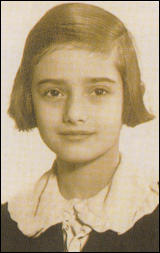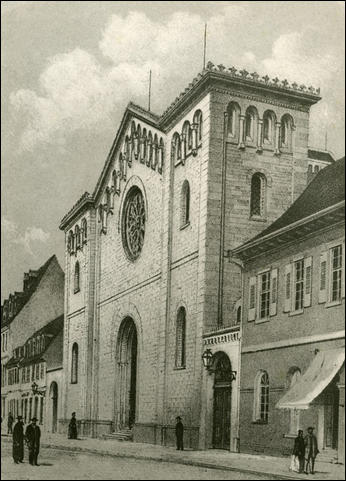Inge Neuberger

Inge Neuberger, the daughter of a Jewish factory owner, was born in Mannheim, Germany, in 1930. (1)
Inge later recalled that on the evening of 9th November, 1938: "my family, which consisted of my father, mother, my maternal grandmother, my older brother, and I were eating dinner when there was a knock at our front door. I can still picture my father's somewhat ruddy complexion turning white, and the quizzical look that passed between my parents. My mother said she would answer the door, and I went with her. There stood a German woman who worked in our home as part-time housekeeper. When my mother asked her what she was doing there, she answered that my father had to leave the house the next day. I recall her saying that something was going to happen, although she did not know what. And she left as quickly and quietly as she had come."
The woman was warning the Neuberger family of what became known as Kristallnacht. "I met my cousin and we walked to school together. I remember that it was a relatively long walk, and as Jews we could not ride the trolley car. We walked along a broad, pedestrian street and came upon an 'army' of men marching four or more abreast. They wore no uniforms but were dressed as working men would have been. Each had a household tool over his shoulder. I remember seeing rakes, shovels, pickaxes, etc., but no guns. My cousin and I were puzzled by this parade, and watched for some minutes. Then we continued on to school." (2)
When she reached the Mannheim Synagogue she discovered it had been very badly damaged. Rolf Dormann, a young Catholic teenager, later remembered witnessing the destruction of the main synagogue, "when furniture was thrown out of the upper windows and Jews were beaten and forced into the street". Recalling the events thirty-five years later, he "could still hear the crash of furniture and still felt shame". (3)
Inge Neuberger later recalled: "We saw a bonfire in the courtyard in front of the synagogue. Many spectators were watching as prayer books and, I believe, Torah scrolls were burned. The windows had been shattered and furniture had been smashed and added to the pyre. We were absolutely terrified. I am fairly certain that the fire department was in attendance, but no attempt was made to extinguish the flames. We ran back to my home to tell my mother what we had seen. She told us that we would leave the apartment and spend the day in Luisenpark, a very large park in town. We spent the entire day in the park, moving from one area to another." (4)

Reinhard Heydrich ordered members of the Gestapo to make arrests following Kristallnacht. "As soon as the course of events during the night permits the release of the officials required, as many Jews in all districts, especially the rich, as can be accommodated in existing prisons are to be arrested. For the time being only healthy male Jews, who are not too old, are to be detained. After the detentions have been carried out the appropriate concentration camps are to be contracted immediately for the prompt accommodation of the Jews in the camps." (5)
Inge Neuberger remembers her father going into hiding and "spent the next six weeks in the attic of our building. I was given strict orders that if anyone asked about my father's whereabouts I was to say that I didn't know where he was. I remember how strongly this was impressed on me." (6)
The family managed to travel to Italy. An uncle in the United States sent the necessary affidavits and money and Inge and her father left in March 1940. Her mother and brother left six weeks later. (7) After attending college Inge became a school teacher.
Inge Neuberger (Janet Ettelman) retired in 1995 and carried out work for the The Holocaust Memorial and Tolerance Center. "I had been teaching about the Holocaust and as a survivor was very eager to participate as a volunteer... The Center has been an extremely important part of my life since that time. When I speak to school groups about my personal experiences in Germany and see the reaction of the students, it makes me… recognize that passing on my story is indeed an important tool for this next generation.” (8)
Primary Sources
(1) Inge Neuberger, letter to Martin Gilbert (15th June, 2005)
My family, which consisted of my father, mother, my maternal grandmother, my older brother, and I were eating dinner (on 9th November, 1938) when there was a knock at our front door. I can still picture my father's somewhat ruddy complexion turning white, and the quizzical look that passed between my parents. My mother said she would answer the door, and I went with her. There stood a German woman who worked in our home as part-time housekeeper. When my mother asked her what she was doing there, she answered that my father had to leave the house the next day. I recall her saying that something was going to happen, although she did not know what. And she left as quickly and quietly as she had come....
The next morning... I met my cousin and we walked to school together. I remember that it was a relatively long walk, and as Jews we could not ride the trolley car. We walked along a broad, pedestrian street and came upon an 'army' of men marching four or more abreast. They wore no uniforms but were dressed as working men would have been. Each had a household tool over his shoulder. I remember seeing rakes, shovels, pickaxes, etc., but no guns. My cousin and I were puzzled by this parade, and watched for some minutes. Then we continued on to school.
We saw a bonfire in the courtyard in front of the synagogue. Many spectators were watching as prayer books and, I believe, Torah scrolls were burned. The windows had been shattered and furniture had been smashed and added to the pyre. We were absolutely terrified. I am fairly certain that the fire department was in attendance, but no attempt was made to extinguish the flames. We ran back to my home to tell my mother what we had seen. She told us that we would leave the apartment and spend the day in Luisenpark, a very large park in town. We spent the entire day in the park, moving from one area to another.
(2) Martin Gilbert, Kristallnacht: Prelude to Destruction (2006)
Some Jews managed to leave Germany in the early months of 1940. Inge Neuberger, an eye-witness of Kristallnacht in Mannheim, left Germany with her father at the end of March. One of her uncles in the United States had sent the necessary affidavits and dollars. Her mother and brother followed six weeks later. They were part of a United States scheme to take a thousand Jewish children and their escorts, provided the children had relatives in the United States to take them in.
(3) The Holocaust Memorial and Tolerance Center (May, 2013)
Janet Ettelman is a Holocaust Survivor who has served HMTC for nearly 20 years. She speaks to student groups across Long Island and has become especially beloved by fifth and sixth grade students and teachers, as well as Center Staff. A native of Mannheim, Germany, Janet witnessed the November Pogrom in 1938. Fortunately, she and her father escaped on the last ship out of Italy; her mother and brother via “The Ten Thousand Children.” She feels fortunate to have the United States as her “new home.”
In the US, Janet pursued a career in education; she taught English and Social Studies. Upon retiring in 1995, “I had been teaching about the Holocaust and as a survivor was very eager to participate as a volunteer [at the Holocaust Center.] The Center has been an extremely important part of my life since that time. When I speak to school groups about my personal experiences in Germany and see the reaction of the students, it makes me…recognize that passing on my story is indeed an important tool for this next generation…” Janet believes strongly in encouraging young people to be upstanders. Without people like Janet, the Center’s same message would be much more difficult to share.
Student Activities
Adolf Hitler's Early Life (Answer Commentary)
Heinrich Himmler and the SS (Answer Commentary)
Trade Unions in Nazi Germany (Answer Commentary)
Adolf Hitler v John Heartfield (Answer Commentary)
Hitler's Volkswagen (The People's Car) (Answer Commentary)
Women in Nazi Germany (Answer Commentary)
German League of Girls (Answer Commentary)
